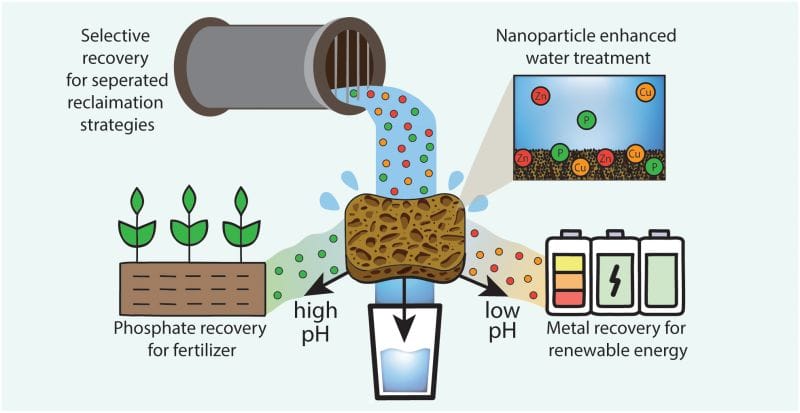RSS feed source: National Science Foundation
Funded by multiple grants from the U.S. National Science Foundation, researchers created a functional sponge that can soak up certain pollutants from water and then release them on demand, presenting a reusable and low-cost solution for cleaning storm runoff while simultaneously recovering valuable metals like zinc and copper, as well as phosphate.
Using surface iron oxide nanoparticles specialized for capturing specific contaminants, the sponge collects the minerals and then discharges them only when triggered by changes in pH, and it can be used multiple times. The findings were achieved by researchers at Northwestern University and published in the American Chemical Society’s journal Environmental Science and Technology Water.
“The technology can be used as a universal sorbent or ‘catch-all,’ or it can be tailored to certain groups of contaminants like metals, plastics or nutrients,” says Vinayak Dravid, a research author and Northwestern professor of materials science and engineering. In previous iterations, the sponge material has successfully pulled lead, microplastics and oil from water.
Industrial manufacturing and agriculture, in particular, experience mineral and fertilizer loss due to runoff, leaving valuable nonrenewable resources as pollutants in bodies of water. Those resources include heavy metals like zinc and copper and also phosphate.
RSS feed source: National Science Foundation
U.S. National Science Foundation-supported research shows that fires in populated areas are three times more likely to lead to premature deaths than wildfires overall, informing fire mitigation efforts.
Scientists at the NSF National Center for Atmospheric Research (NSF NCAR) led the study, published in Science Advances, which found that smoke from fires that blaze through the wildland-urban interface (WUI) has far greater health impacts than smoke from wildfires in remote areas.
“This research will support the development of advanced fire prevention strategies, improve building codes and lead to effective emergency response plans,” said Bernard Grant, a program director in the NSF Directorate for Geosciences. “It will help protect lives and homes, safeguard natural ecosystems and reduce the economic burden of wildfire disasters,”
The researchers used an advanced NSF NCAR-based computer model, the Multi-Scale Infrastructure for Chemistry and Aerosols, to simulate pollutants from fires. Their modeling included carbon monoxide chemical tracers, which allowed them to estimate emission sources and differentiate between wildland and WUI fires.
“The health impacts are proportionately large because they’re close to human populations,” said NSF NCAR scientist Wenfu Tang, the report’s lead author. “Pollutants emitted by WUI fires, such as particulate matter and the precursors to ozone, are more harmful because they’re not dispersing across hundreds or thousands of miles.”
Click this link to continue reading the article on the source website.
RSS feed source: National Science Foundation
A new study by U.S. National Science Foundation-funded researchers on how members of the animal world sense and react to sounds provides insight into adaptations in communication that could be used in the development of adaptable hearing aids or limiting the impact of agricultural pests.
“By increasing our understanding of how animals perceive and respond to sounds — especially when those sounds are changing — this research could aid in developing hearing aids that automatically tune as a person walks from a movie theater to a crowded restaurant or other adaptive hearing and acoustics devices,” said Jodie Jawor, a program director in the NSF Directorate for Biological Sciences. “It also highlights how agricultural pests can move into an area and capitalize on a new host, harming society in the process — think about a parasite of honeybees that hurts their populations and our food supply.”
The study focused on the interactions between a species of fly (Ormia ochracea) and Pacific crickets, which are engaged in a sort of sound arms race. The fly can hear the mating chirps of the male cricket and uses the sounds to locate the male, in which the fly lays its eggs. The fly larvae feed on and develop inside of their cricket hosts, eventually killing them when they emerge. Some crickets in Hawaii have responded to this threat
Click this link to continue reading the article on the source website.
RSS feed source: National Science Foundation
A new study supported by the U.S. National Science Foundation shows, for the first time, how heat moves — or rather, doesn’t — between materials in a high-energy-density plasma state. The work is expected to provide a better understanding of inertial confinement fusion experiments, which aim to reliably achieve fusion ignition on Earth using lasers. How heat flows between a hot plasma and a material’s surface is also important in other technologies, including semiconductor etching and vehicles that fly at hypersonic speeds.
High-energy-density plasmas are produced only at extreme pressures and temperatures. The study shows that interfacial thermal resistance, a phenomenon known to impede heat transfer in less extreme conditions, also prevents heat flow between different materials in a dense, super-hot plasma state. The research is published in Nature Communications and was led by Thomas White, a physicist at the University of Nevada, Reno, and his former doctoral student, Cameron Allen. White is a recipient of an NSF Faculty Early Career Development grant.
“Understanding how energy flows across a boundary is a fundamental question, and this work provides us with new insights into how this happens in the exceptionally energy-dense environments that one finds inside of stars and planetary cores,” says Jeremiah Williams, a program director for the NSF Plasma Physics program.



